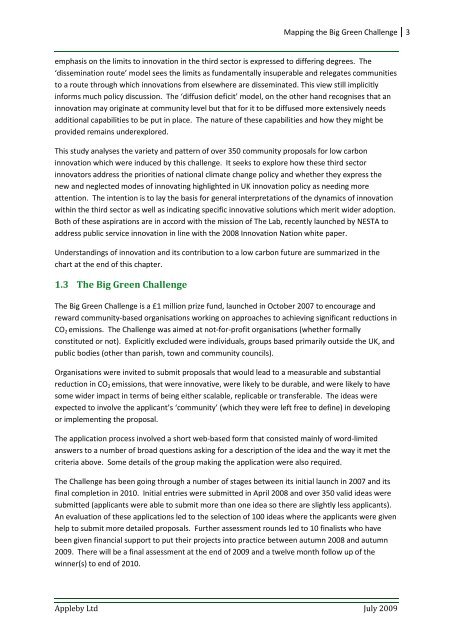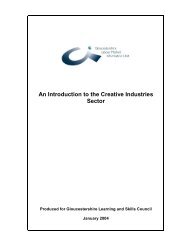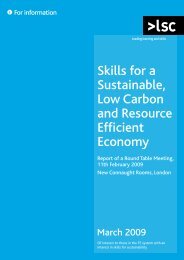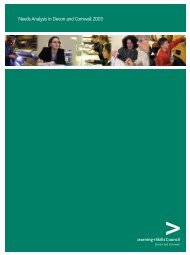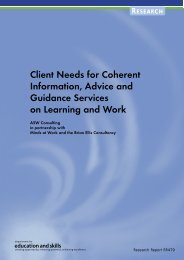Mapping the Big Green Challenge - The Skills & Learning ...
Mapping the Big Green Challenge - The Skills & Learning ...
Mapping the Big Green Challenge - The Skills & Learning ...
You also want an ePaper? Increase the reach of your titles
YUMPU automatically turns print PDFs into web optimized ePapers that Google loves.
<strong>Mapping</strong> <strong>the</strong> <strong>Big</strong> <strong>Green</strong> <strong>Challenge</strong> 3emphasis on <strong>the</strong> limits to innovation in <strong>the</strong> third sector is expressed to differing degrees. <strong>The</strong>‘dissemination route’ model sees <strong>the</strong> limits as fundamentally insuperable and relegates communitiesto a route through which innovations from elsewhere are disseminated. This view still implicitlyinforms much policy discussion. <strong>The</strong> ‘diffusion deficit’ model, on <strong>the</strong> o<strong>the</strong>r hand recognises that aninnovation may originate at community level but that for it to be diffused more extensively needsadditional capabilities to be put in place. <strong>The</strong> nature of <strong>the</strong>se capabilities and how <strong>the</strong>y might beprovided remains underexplored.This study analyses <strong>the</strong> variety and pattern of over 350 community proposals for low carboninnovation which were induced by this challenge. It seeks to explore how <strong>the</strong>se third sectorinnovators address <strong>the</strong> priorities of national climate change policy and whe<strong>the</strong>r <strong>the</strong>y express <strong>the</strong>new and neglected modes of innovating highlighted in UK innovation policy as needing moreattention. <strong>The</strong> intention is to lay <strong>the</strong> basis for general interpretations of <strong>the</strong> dynamics of innovationwithin <strong>the</strong> third sector as well as indicating specific innovative solutions which merit wider adoption.Both of <strong>the</strong>se aspirations are in accord with <strong>the</strong> mission of <strong>The</strong> Lab, recently launched by NESTA toaddress public service innovation in line with <strong>the</strong> 2008 Innovation Nation white paper.Understandings of innovation and its contribution to a low carbon future are summarized in <strong>the</strong>chart at <strong>the</strong> end of this chapter.1.3 <strong>The</strong> <strong>Big</strong> <strong>Green</strong> <strong>Challenge</strong><strong>The</strong> <strong>Big</strong> <strong>Green</strong> <strong>Challenge</strong> is a £1 million prize fund, launched in October 2007 to encourage andreward community-based organisations working on approaches to achieving significant reductions inCO 2 emissions. <strong>The</strong> <strong>Challenge</strong> was aimed at not-for-profit organisations (whe<strong>the</strong>r formallyconstituted or not). Explicitly excluded were individuals, groups based primarily outside <strong>the</strong> UK, andpublic bodies (o<strong>the</strong>r than parish, town and community councils).Organisations were invited to submit proposals that would lead to a measurable and substantialreduction in CO 2 emissions, that were innovative, were likely to be durable, and were likely to havesome wider impact in terms of being ei<strong>the</strong>r scalable, replicable or transferable. <strong>The</strong> ideas wereexpected to involve <strong>the</strong> applicant’s ‘community’ (which <strong>the</strong>y were left free to define) in developingor implementing <strong>the</strong> proposal.<strong>The</strong> application process involved a short web-based form that consisted mainly of word-limitedanswers to a number of broad questions asking for a description of <strong>the</strong> idea and <strong>the</strong> way it met <strong>the</strong>criteria above. Some details of <strong>the</strong> group making <strong>the</strong> application were also required.<strong>The</strong> <strong>Challenge</strong> has been going through a number of stages between its initial launch in 2007 and itsfinal completion in 2010. Initial entries were submitted in April 2008 and over 350 valid ideas weresubmitted (applicants were able to submit more than one idea so <strong>the</strong>re are slightly less applicants).An evaluation of <strong>the</strong>se applications led to <strong>the</strong> selection of 100 ideas where <strong>the</strong> applicants were givenhelp to submit more detailed proposals. Fur<strong>the</strong>r assessment rounds led to 10 finalists who havebeen given financial support to put <strong>the</strong>ir projects into practice between autumn 2008 and autumn2009. <strong>The</strong>re will be a final assessment at <strong>the</strong> end of 2009 and a twelve month follow up of <strong>the</strong>winner(s) to end of 2010.Appleby Ltd July 2009


